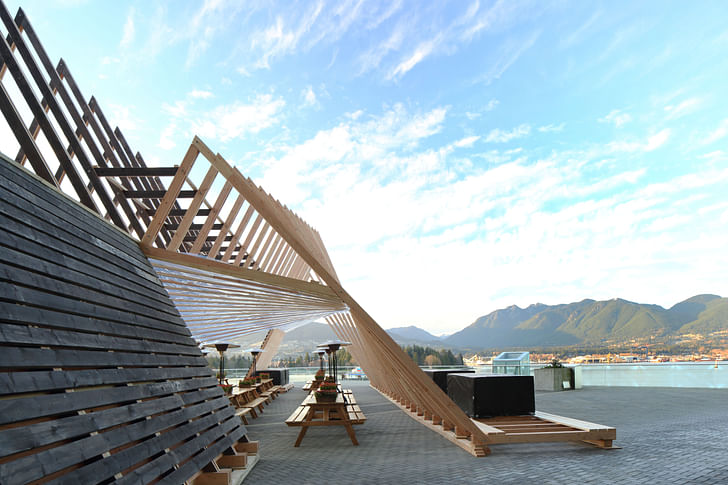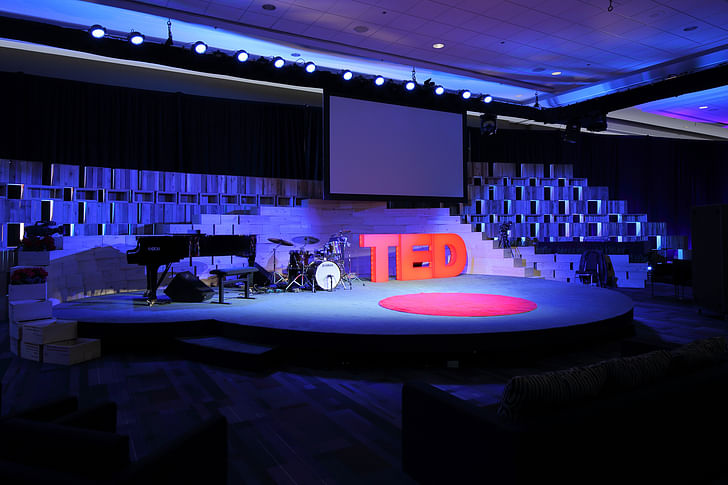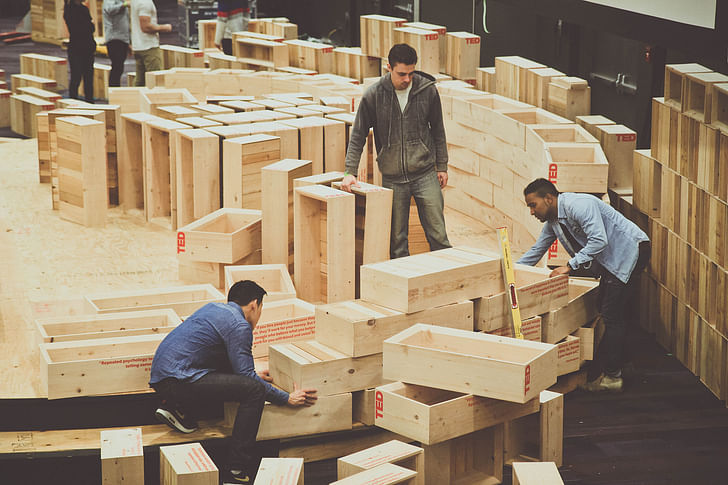

In some veins of architecture pedagogy, there seems to be a movement towards new technology at the expense of hands-on construction techniques. In the opinion of architect Michael Green and creative entrepreneur Scott Hawthorn, these schools increasingly churn out graduates who are so moored in abstraction that they have very little practical ability. This is problematic in a field where clients and real, physical buildings often refuse to be abstract. Design Build Research (DBR), based in Vancouver, British Columbia, is Green and Hawthorn’s solution to schools that isolate designers from the community for which they design.
Currently a non-profit institute that takes undergraduate and graduate design students but hopes to begin enrolling participants from as early as the sixth grade, the project aims to give designers hands-on experience in projects that socially or culturally benefit their local communities.
DBR informally began in 2013 when Green was asked to give a TED talk about his progressive wood work in architecture, and he built a progressively wood-worked stage to illustrate. When the TED organization asked Green if he would be interested in building a theater for their headquarters’ move from Long Beach, California to Vancouver the following year, he suggested that it should be done as a design-build project with students. He approached the University of British Columbia for help, but the project did not fit their program. Instead, Green rented his own space and asked four different colleges for students from their design programs. The subsequent success of this second stage prompted Green to officially start his own school.

Green enlisted the help of his old friend Scott Hawthorn, and along with wood engineer Eric Karsh, the three of them formed the board of DBR in 2014. In the brief stint since, the school has built fruit stands in orchards, a waterfront marquee, and cabins for sommeliers on a vineyard. Each “course” of the school is centered on completing a particular design-build project. Its faculty comprises fellow practicing architects, with hopes to expand to include more experienced, retired designers who wish to mentor the next generation.
What’s striking about DBR’s model is how it seems to solve one of the conundrums facing the profession: how to transition students into effective architectural employees, without exploiting them financially, or inflating a firm’s overhead.DBR hopes to specifically foster design aptitude that would otherwise be crushed in traditional academic settings By creating a culture of mentorship that also gives students practical experience, the program hopes to prepare students to enter the workforce with employable skills, sparing them from unpaid internships while still benefitting their new employers. Ethics form the backbone of DBR’s philosophy: while the institution eventually would like to franchise its pedagogy across the United States, the board isn’t rushing into any agreements. They recently turned down a franchising offer from a well-heeled foundation, partially because Green and Hawthorn are both fully occupied running their respective businesses to thoughtfully expand.
By proposing to take in students as young as 12 years old, DBR hopes to specifically foster design aptitude that would otherwise be crushed in traditional academic settings. “One of the observations I made is that as a kid in [Canada’s] public school system, around grade six, when the teacher says ‘can you draw me a picture, can you build me a structure’ every kid happily dives in,” Green told me over the phone.Many students enter design school intending to positively contribute to social or environmental issues, but come out focused on finding the shortest route to landing a magazine cover “By the time we get to grade eight or nine, only a handful of kids will raise their hands and draw a picture or build something. And by grade 11 or 12, only one or two kids will still retain those drawing and building and creative skills. It’s a universal problem. For some reason we take this incredible creativity kids have and throw them into high schools and sort of put them into a structure where that’s no longer valued, and therefore they lose those skills. And we collectively lose this incredible life skill that we’re all equipped with.”
In addition to sustaining this innate creative impulse, DBR’s emphasis on practicality is engineered to help design students retain a certain down-to-earth quality, an aspect that in the age of starchitecture can seem quaint. Green has noticed that many students enter design school intending to positively contribute to social or environmental issues, but come out focused on finding the shortest route to landing a magazine cover. “We tend to stay on the practical side of the conversation; how do you execute an idea, how does that idea benefit the community?” Green explained. “That can come packed with really high philosophical ambitions, but at the end of the day, it still has to be practical.”


DBR’s emphasis on giving students the skills to realize their own designs benefits all parties involved. It creates professionals who are able to interface with the non-architectural crowd, i.e, the majority of people who will actually engage with their structures. Teepee in a Box, a project of Green’s which pre-dates butdisconnection is one of the greatest flaws of the design community today heavily influenced DBR’s course style, is instrumental to the school’s mission of tangibly addressing the needs of the community. Teepee is best described as a playspace next to a fast-food restaurant that (living up to its titular promise) houses a tent-like structure in a wooden, open-air square. While it could also be described as a conceptual installation about the difficulties of creating an environment for play in a public space, those aren’t the words that stick locally.
Teepee is engineered to withstand the full-on horsing-around power of kids while simultaneously giving them a secure place to act out their own imagination (and occasionally, a respite for and from their parents). Crucially, Green designed the structure with direct input from one of the project’s ultimate users: his son, Malaku. “That’s the missing piece in design school,” Green said. “Unless you actually make it and show how it works in the design community and watch people use it, especially if it’s a building or object, as a designer you remain disconnected, and that disconnection is one of the greatest flaws of the design community today.”

Perhaps most importantly for designers, learning how to interface with the outside community doesn’t necessarily dumb-down the architecture, but rather opens up a dialogue for seemingly remote ideas to be articulated in aBy becoming involved with the community, designers benefit from the world's finest teacher: experience more straightforward way. This reflects the underlying goal of DBR, which purposefully designs its courses so that end results may be integrated into the local community for the long-term. Even a seemingly temporary course has a second iteration: The Lions Marquee, initially built as a waterfront picnic space for TED 2015, will be relocated to downtown Vancouver to become a market.
“The value designers have in society is often challenged by the fact that the outside community doesn’t understand the value and doesn’t really hear the story of how a better quality design makes life better,” Green explained. “By getting out into the community, our students and programs can hopefully start to reverse that relationship that designers have by using very practical, very honest, simple, understandable language.” Of course, by becoming involved with the community, designers benefit from the world’s finest teacher: experience.
Julia Ingalls is primarily an essayist. Her work has appeared or is forthcoming in Slate, Salon, Dwell, Guernica, The LA Weekly, The Nervous Breakdown, Forth, Trop, and 89.9 KCRW. She's into it.
2 Comments
I was a part of the TED Talk stage design/build (I`m in the last photo actually!). It was a fantastic experience and I learned a lot. I ripped thousands of feet rabbet cuts and am a pro with the tablesaw now. Having learned extremely little about construction and the act of assembling things in school, this program offered an awesome addition to my design education. It was lots of hard work but seeing the finished project and attending the first round of TED speakers was worth it!
I totally agree that many students leave school with very little construction knowledge as I was one of them after completing my bachelor`s program. Between doing this program and landing a full-time design/build gig around the same time I now feel much more confident in my design decisions. Looking forward to going for my M.Arch in a few years with conceptual as well as practical knowledge under my belt.
I love the idea of hands on, but it might be a lot easier to give students Studio assignments with the kind of programs that a young architect might find after graduation. Invite a non-architect to the crit to help the student communicate effectively outside the ivory tower.
Block this user
Are you sure you want to block this user and hide all related comments throughout the site?
Archinect
This is your first comment on Archinect. Your comment will be visible once approved.